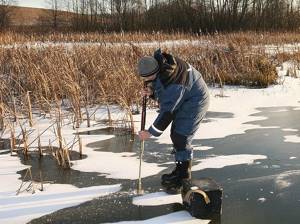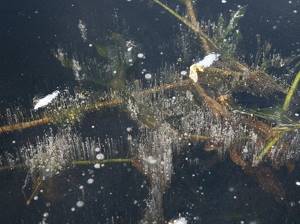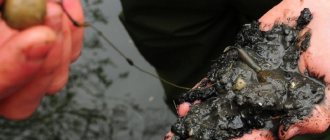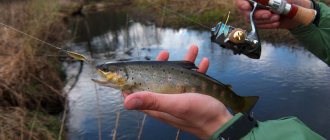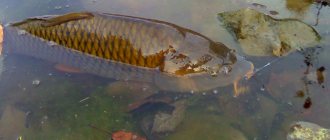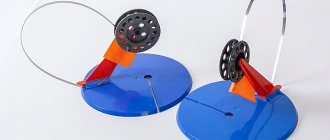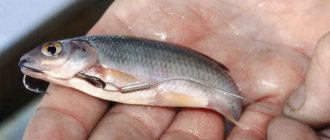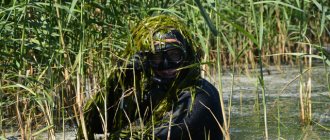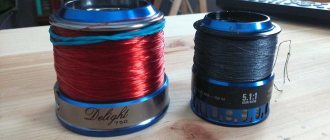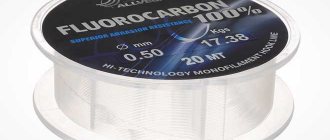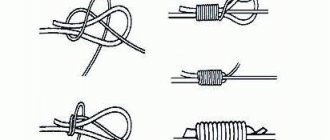Yuri 09.09.2020 400
Winter fishing is characterized by some discomfort and the emergence of risks, which are minimized by observing safe ice thickness values on the reservoir. No one will refuse such an adrenaline rush as winter fishing, so in this article we suggest protecting yourself with thoughtful behavior on ice cover.
Time of ice formation
For many fishermen, the winter season begins with the first days of freezing, for others it is the months of November and December. The first of them neglect possible risks, going out onto thin ice that literally breathes under their feet. You should not rely on the calendar, since each year is characterized by different freeze-up times (temperature anomalies and indicators of the past summer season).
For the eastern and northern regions of the Astrakhan region, a more favorable picture begins in mid-December. However, we take into account possible thaws, when positive values are noted - the ice at this moment weakens and becomes less durable.
Ice growth is always quite fast. If today its thickness is slightly less than 10 cm, then per day at a temperature of -5 degrees the cover grows by an average of 4 cm. Ice is a natural thermal layer that protects the reservoir from complete freezing, as a result of which the population of underwater inhabitants is preserved.
Safety precautions for ice fishing
Moving in groups, using protective equipment, is a reliable way to protect your life. However, the risk of taking an ice bath remains.
To minimize the possibility of an accident, you can only walk on ice if you know its exact thickness.
Taking into account the general safety rules on ice, an adult can move confidently once it reaches a thickness of 10 cm.
You can use a motorized towing vehicle (motorized dog) if the minimum thickness is 10-15 cm. The indicator depends on the weight and size of the equipment.
You should drive a passenger car with a thickness of 20-25 cm. A heavy SUV or minibus - from 30 cm. But even these data apply to clean, strong ice. Snow crust is not taken into account in any case; it practically does not add strength.
Basic safety recommendations are as follows:
- You cannot perform sudden actions (jumping, running, etc.) when moving on the ice. The first ice is also dangerous because it is slippery. In addition to the risk of falling, you can get a serious injury if you fall.
- The appearance of cracks in ice greatly reduces its strength. The most dangerous are cracks in the form of a web that surrounds a person on all sides in a circle. Such places should be avoided immediately when water begins to appear - it may already be too late.
- When going out onto a body of water, you need to pay attention to the thickness and color of the ice cover. Light ice is weaker than black ice due to its low density. It is better to avoid such places when there is first ice.
- For safe movement, it is recommended to stick to those areas where there is already a trail.
- They move in a group, maintaining a distance between pedestrians of at least 2 meters.
- You can use skis that ensure even distribution of the load. If necessary, the leg should be immediately released from the fastening.
- The backpack should be worn with only one strap. This moment allows you to quickly reset it if necessary.
- To increase safety, a rope is required, the optimal length of which is about 25 meters.
- Warm woolen or cotton clothing becomes unbearable when wet. It is advisable to use modern, lightweight, non-oversized clothing made from synthetic materials.
By taking precautions you can significantly reduce the risk to your own life. Typically, the required skills are acquired over time. It is better to start winter fishing with someone who has experience.
We recommend reading: Fishing screwdriver: choosing a model and nuances
Choosing a safe indicator
For any experienced winter traveler, the most productive fishing is on the first ice. At this time, not all the fish go to wintering holes, and even a novice angler can successfully catch with a jig. However, no catch is worth risking human health. Therefore, lovers of winter fishing, never go out on the ice if its thickness does not exceed the safe value of 7 cm. At the same time, guaranteed safety appears when the ice thickness is 10 cm or more, and then precautions must be taken.
These indicators are recommended if the water in the reservoir is fresh. Therefore, it is worth considering other options:
- If the ice thickness is about 8 cm, be sure to use skis when moving in order to distribute the load from the body over a larger area. Especially if the water area is heavily covered with snow, there may be thawed areas underneath. You won't fail on skis in such a situation.
- If you mean moving on a snowmobile, then the ice thickness should be at least 12-15 cm.
- In salt water or mixed with sea water, the ice should be thicker, and this figure should not be lower than 15 cm.
- If there are children on the ice who have come to have fun skating, for such games the minimum ice thickness is 12 cm.
- With official permission, pedestrians can cross the ice in a designated place, where the thickness reaches at least 15 cm. Outside the place of organized movement of pedestrians, you become your own responsibility - only you are responsible for your safety.
- For road crossings, the ice thickness must be at least 30 cm - organized road crossings on ice. Such places are marked accordingly.
Stages of safe ice formation.
At the first stage, the mass necessary for the appearance of ice cover is formed.
Formation of primary ice:
- Crystal formation. At this stage, ice needles form.
- Salo education. The moment of formation of ice lard.
- Mass education. At this stage, the icy fat forms large snow fields - snowstorms.
At the second stage, the ice cover of water bodies is formed directly.
- Ice formation:
- Appearance of pancake ice. These are floating individual pieces of ice. These ice pancakes are very loose and fragile. You can't step on them.
- Ice crust formation. The crust can reach five centimeters in thickness, but will not support the weight of a person.
- The appearance of a thin layer of ice. This ice is much stronger than previous ice.
- The appearance of gray ice. Such ice is often called young ice. With prolonged frost, gray ice lightens and turns into white ice.
- Formation of white ice. This is the kind of ice that fishermen are waiting for. It's the start of the winter fishing season.
Even when boldly walking on white ice, you should not forget that there is an elastic slab under your feet. Such a slab is constantly subject to deformation under the influence of loads and flow. This is how cracks appear. In addition, the thickness of the slab is not uniform; there are even holes in it.
How safe ice grows.
In calm and quiet weather on lakes and ponds, the rate of ice formation is 2.5 millimeters per day per degree. For example, when the air temperature is minus five degrees, an ice cover 12.5 millimeters thick forms in one day. This is only in theory.
This rule does not work on large reservoirs, rivers and artificial reservoirs. Large masses of water in deep places cool more slowly than in shallow waters and the ice grows unevenly. When there is freezing, it often snows. Even a thin layer of snow slows ice growth.
A thick layer of snow on thin ice melts the ice. Water seeps through the cracks that form and melts the top layer of ice. This is a very dangerous phenomenon for winter fishing enthusiasts.
Safe ice. The rate of increase in ice thickness in large reservoirs.
| Air temperature | Initial ice thickness 0 cm. Growth rate cm per day | Initial ice thickness 10 cm. Growth rate cm per day |
| -5 | 0,5 | 0,5 |
| -10 | 1,1 | 0,9 |
| -15 | 1,6 | 1,3 |
| -20 | 2,1 | 1,9 |
| -25 | 2,8 | 2,2 |
How to determine ice strength
In practice, measuring the thickness of the cover is difficult. It is recommended to wait for official messages from the services in your region where it is allowed to go on the ice. Stable frosty weather should persist for at least a week from the moment of freezing.
- Based on the color of the cover, we determine that the most durable and safe ice is shades of greenish and bluish. A loose and spongy structure with a gray color indicates an unsafe ice thickness.
- Water on the surface indicates that the ice has not yet strengthened and it is strictly not recommended to go out.
- When you step onto the ice, you hear a characteristic sound, a cracking sound, a popping sound, and immediately go ashore.
For an angler, it is much easier to estimate the thickness of the ice - just drill a hole and approximately determine this indicator. An experienced fisherman will immediately understand whether it is worth going further into the reservoir or not. You should be especially careful with snowdrifts, as danger may be hidden underneath them.
Strong currents and springs are characterized by the presence of potholes, which are not noticeable from above and are covered with a thin layer of snow. Wetlands are characterized by a greenhouse effect, where even severe frosts are not able to consolidate the ice cover. In places where wastewater is discharged, we also exercise extreme caution (here there is a heterogeneous coating with different flows).
TAGS:
How is safe ice formed?
The rainy autumn is ending, the air temperature drops below zero. During this period, water bodies begin to become covered with ice. This type of ice is called surface ice. It is formed from a huge amount of frozen water crystals.
On ponds and lakes protected from the wind, the surface ice is solid. It is formed in the direction from the shore to the middle of the reservoir. Ice grows in thickness only because of the crystals formed below. From above it can only melt. In ponds and lakes, the first ice is distinguished by its increased strength and transparency.
In rivers and large artificial reservoirs, where there is no calm water due to the wind, the resulting ice contains many air bubbles. Therefore, the ice is opaque and relatively weak.
The most dangerous water-snow ice. This ice forms when water and snow mix. It is clearly visible in a body of water - it is highly porous and gray in color. It is best to avoid such places on the reservoir.
Tags
Carp Buffalo Spring Vobla Asp Winter Crucian Rudd Summer Fishing baits Lower Volga Perch Autumn Fisherman's reminder Lures Bite forecast Fishing in Astrakhan Fishing baits Fishing tackle Fishing secrets Catfish Fishing methods Pike perch Catch Pike
The first ice is like New Year's, only better
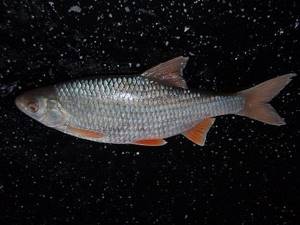
Photo: Andrey Yanshevsky. The arrival of winter in the Moscow region this year evokes nostalgia for the “old” times of the 70-80s, when the rule worked - from December 10 you can fish from ice on all reservoirs near Moscow.
Something similar is happening now.
Friendly and rapid formation of ice occurs in frosty, windless weather and high atmospheric pressure, that is, under stable atmospheric conditions.
Usually, 4-6 days at frost temperatures of about 10 degrees are enough for the ice to reach a safe thickness of 6-15 cm.
Such a large variation in ice thickness is typical not only for different bodies of water, but also for large flowing water areas.
The usual picture is that in the bays the ice is 10 cm, on the riverbed irrigation 5-6, and on the riverbed no more than a centimeter.
A special case is peat quarries.
In open water, ice can form very quickly, but getting to it is problematic.
You can, of course, wear wide skis, but if you fall through a swamp on them, you’ll have to give up your festive mood.
It is not the first ice itself that is dangerous, but the behavior on it. If you walk with an ice pick and carefully look at your feet, the likelihood of swimming will be minimal. They fail due to a simple loss of vigilance or inexperience.
|
| Ice lice is needed once a year, but it is necessary! Photo: Andrey Yanshevsky. |
Another, in my opinion, more interesting question is why it is or is not worth crawling onto the first ice. Besides the adrenaline rush, is there also a fishing incentive?
Personally, I think there is, but the opportunity to catch the desired fish still needs to be realized, and this is not so easy.
Read the material “Lady Luck”
Thin ice only gives us the opportunity to move around the entire body of water and make an unlimited number of holes.
But the appearance of a solid boundary between water and air significantly changes the behavior of aquatic inhabitants. These changes in behavior are not always and not always expressed in active pecking.
The best scenario for the development of events in terms of biting is now observed in the Moscow region - a cold snap without sharp fluctuations in the average daily temperature in conditions of high and stable atmospheric pressure.
In addition to pressure, wind direction is important. The worst weather is when the wind is “twisting”. Just like humans and other animals, fish are certainly influenced by factors such as magnetic disturbance and illumination. All these factors, one way or another, are interconnected, and the faster they change, the worse living organisms feel.
The fish's hunger associated with the appearance of ice is very short-lived and begins a few days after the ice covers the reservoir. The thickness of the ice does not matter to the fish.
The first few days the fish are “sick” and take poorly, with the exception of pike. Then comes a period of very active biting, which lasts from two to three days to two weeks, and then winter comes for the fish.
In addition to the weather, the activity of fish is influenced by the saturation of the food supply of the reservoir. It is on the first ice that fish are most active in water bodies that are not rich in food. First of all, these are careers.
Read the material “When your instincts failed you”
In small small reservoirs, fish “understand” that a hungry winter will come for them much earlier than their relatives from a reservoir or river, so they can bite tolerably even in bad weather.
|
| The ice rose so quickly that the air did not have time to escape from the leaves. Photo: Andrey Yanshevsky. |
It is also important that a small body of water is much easier and more efficient to explore and find a place where fish are active.
Regardless of the type and size of the reservoir, the weather and the time of year, there are places on the reservoirs in which there are fish, and there are places in which the fish eat. And these places do not always coincide.
On the first ice they most often coincide, which largely contributes to good catches.
This season, perhaps, you shouldn’t waste your time on lakes and ponds, but immediately start with a large quarry or bay of a reservoir.
I love deep careers. Here, the combination of the activity of the fish itself and the versatility of fishing in the coastal zone, on the edges and in deep watering gives not only a good chance of catching large fish, but also allows you to purposefully catch not what is biting, but what you want to catch.
It is appropriate to say that it makes sense to set yourself up for a specific type of fishing, but take the entire set of gear with you. It often happens that you go after a perch with a spoon, and already on the spot it turns out that a flock of decent-sized bream has entered the bay of the reservoir, which is actively moving and biting on the jig.
Or the perch suddenly went on strike today due to the weather, but roach is excellently caught in the shallows, using small jigs baited with bloodworms.
Read the material “First Ice for the most impatient”
True, in this approach lies the biggest mistake of insufficiently experienced fishermen.
They take everything they have with them, but instead of choosing a specific tactic on the spot, they start feeding the holes for the bream, then they set up the baits, twitch the spoon for a while, and then start shaking the jig.
The result is predictable, but fun.
Happy First Ice!
Andrey Yanshevsky December 8, 2021 at 10:22 am
